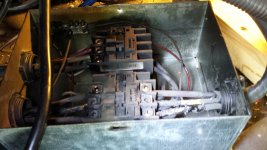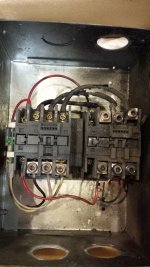I spoke at some length with Dave Watson at Progressive Dynamic Service. He was a bit surprised when he saw the photos. Said he doesn't usually see damage like that on both sides of the switch. The typical damage is on one side. His thought was it was probably due to a slightly loose/damaged wire at installation and that it degraded over time until there was so much damage that the relay would no longer operate. He said it could also have been started by contact pitting/damage (but I think he thought that was much lower probability). He also agreed that whether a loose/damaged wire or pitted contacts, the result was higher resistance driving higher amperage and high heat, damaging the wires and switch mechanisms, in turn worsening the situation until there was a failure of the relay to hold contact in either direction (shore or generator).
After this call, my guess, based on fairly symmetrical damage, is that it was not a loose wire, but rather was a contact problem. If it were a loose wire, based on Dave's comments, I think the damage would have been more severe on the side with the loose wire.
I asked him about the recommendation on this forum to turn off the main breakers inside so there's no load on the switch when applying power (shore or generator). He agreed that there's potential for arcing if the switch is powered when there's a load on the system and said turning the breakers off sounded like a good practice. But I don't think he would have gone so far as to say you have to do so to protect the switch.
He mostly sees defective units that are under warranty, so I suspect that may bias his experience toward installation issues rather than longer term wear and tear.
I did learn that the relay at rest doesn't pass power. It's energized for shore or generator and is held in the appropriate energized position the entire time power is applied from either source.
Brian, my EMS is on the shore power side.


